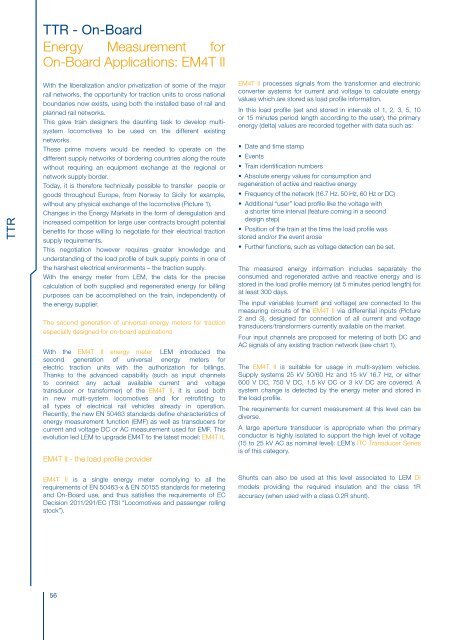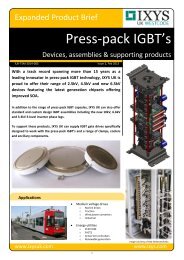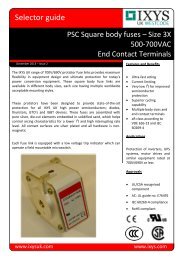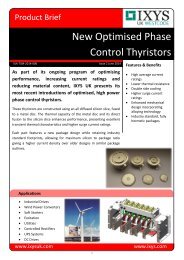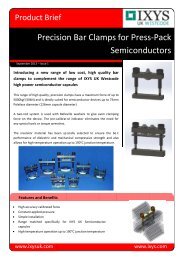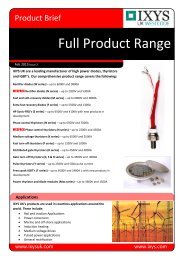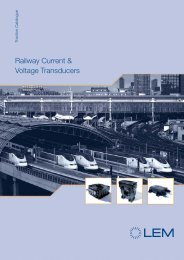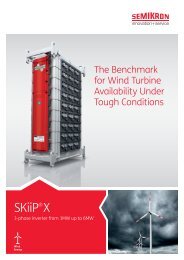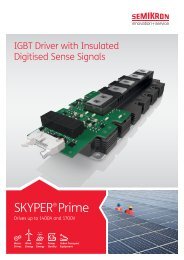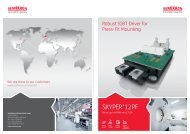industry current voltage transducers
Create successful ePaper yourself
Turn your PDF publications into a flip-book with our unique Google optimized e-Paper software.
TTR - On-Board<br />
Energy Measurement for<br />
On-Board Applications: EM4T II<br />
TTR - On-Board<br />
Picture 1 :<br />
European rail networks<br />
TTR<br />
With the liberalization and/or privatization of some of the major<br />
rail networks, the opportunity for traction units to cross national<br />
boundaries now exists, using both the installed base of rail and<br />
planned rail networks.<br />
This gave train designers the daunting task to develop multisystem<br />
locomotives to be used on the different existing<br />
networks.<br />
These prime movers would be needed to operate on the<br />
different supply networks of bordering countries along the route<br />
without requiring an equipment exchange at the regional or<br />
network supply border.<br />
Today, it is therefore technically possible to transfer people or<br />
goods throughout Europe, from Norway to Sicily for example,<br />
without any physical exchange of the locomotive (Picture 1).<br />
Changes in the Energy Markets in the form of deregulation and<br />
increased competition for large user contracts brought potential<br />
benefi ts for those willing to negotiate for their electrical traction<br />
supply requirements.<br />
This negotiation however requires greater knowledge and<br />
understanding of the load profi le of bulk supply points in one of<br />
the harshest electrical environments – the traction supply.<br />
With the energy meter from LEM, the data for the precise<br />
calculation of both supplied and regenerated energy for billing<br />
purposes can be accomplished on the train, independently of<br />
the energy supplier.<br />
The second generation of universal energy meters for traction<br />
especially designed for on-board applications<br />
With the EM4T II energy meter, LEM introduced the<br />
second generation of universal energy meters for<br />
electric traction units with the authorization for billings.<br />
Thanks to the advanced capability (such as input channels<br />
to connect any actual available <strong>current</strong> and <strong>voltage</strong><br />
transducer or transformer) of the EM4T II, it is used both<br />
in new multi-system locomotives and for retrofitting to<br />
all types of electrical rail vehicles already in operation.<br />
Recently, the new EN 50463 standards define characteristics of<br />
energy measurement function (EMF) as well as <strong>transducers</strong> for<br />
<strong>current</strong> and <strong>voltage</strong> DC or AC measurement used for EMF. This<br />
evolution led LEM to upgrade EM4T to the latest model: EM4T II.<br />
EM4T II - the load profi le provider<br />
EM4T II processes signals from the transformer and electronic<br />
converter systems for <strong>current</strong> and <strong>voltage</strong> to calculate energy<br />
values which are stored as load profile information.<br />
In this load profile (set and stored in intervals of 1, 2, 3, 5, 10<br />
or 15 minutes period length according to the user), the primary<br />
energy (delta) values are recorded together with data such as:<br />
• Date and time stamp<br />
• Events<br />
• Train identification numbers<br />
• Absolute energy values for consumption and<br />
regeneration of active and reactive energy<br />
• Frequency of the network (16.7 Hz, 50 Hz, 60 Hz or DC)<br />
• Additional “user” load profile like the <strong>voltage</strong> with<br />
a shorter time interval (feature coming in a second<br />
design step)<br />
• Position of the train at the time the load profile was<br />
stored and/or the event arose<br />
• Further functions, such as <strong>voltage</strong> detection can be set.<br />
The measured energy information includes separately the<br />
consumed and regenerated active and reactive energy and is<br />
stored in the load profile memory (at 5 minutes period length) for<br />
at least 300 days.<br />
The input variables (<strong>current</strong> and <strong>voltage</strong>) are connected to the<br />
measuring circuits of the EM4T II via differential inputs (Picture<br />
2 and 3), designed for connection of all <strong>current</strong> and <strong>voltage</strong><br />
<strong>transducers</strong>/transformers <strong>current</strong>ly available on the market.<br />
Four input channels are proposed for metering of both DC and<br />
AC signals of any existing traction network (see chart 1).<br />
The EM4T II is suitable for usage in multi-system vehicles.<br />
Supply systems 25 kV 50/60 Hz and 15 kV 16.7 Hz, or either<br />
600 V DC, 750 V DC, 1.5 kV DC or 3 kV DC are covered. A<br />
system change is detected by the energy meter and stored in<br />
the load profile.<br />
The requirements for <strong>current</strong> measurement at this level can be<br />
diverse.<br />
A large aperture transducer is appropriate when the primary<br />
conductor is highly isolated to support the high level of <strong>voltage</strong><br />
(15 to 25 kV AC as nominal level): LEM’s ITC Transducer Series<br />
is of this category.<br />
PORTUGAL<br />
CP<br />
IRELAND<br />
IE<br />
SPAIN<br />
RENFE<br />
BR<br />
UNITED KINGDOM<br />
FRANCE<br />
DENMARK<br />
NETHERLANDS<br />
SNCF<br />
NS<br />
BELGIUM<br />
SNCB<br />
SWITZERLAND<br />
SBB/CFF/FFS<br />
MONACO<br />
NORWAY<br />
NSB<br />
GERMANY<br />
DB AG<br />
FS<br />
ITALY<br />
SWEDEN<br />
SJ<br />
CD<br />
AUSTRIA<br />
OBB<br />
SLOVENIA<br />
SZ<br />
CROATIA<br />
HZ<br />
POLAND<br />
PKP<br />
ZSR<br />
LITHUANIA<br />
SLOVAKIA<br />
HUNGARY<br />
MAV<br />
BOSNIA<br />
AND HERZEGOVINA<br />
MONTENEGRO<br />
FINLAND<br />
VR<br />
ZBH JZ<br />
ESTONIA<br />
LATVIA<br />
KOSOVO<br />
ALBANIA<br />
EVR<br />
LDZ<br />
MACEDONIA<br />
OSE<br />
GREECE<br />
BELARUS<br />
BZD<br />
ROMANIA<br />
SNCFR<br />
BULGARIA<br />
BDZ<br />
UKRAINE<br />
RUSSIAN FEDERATION<br />
RZD<br />
FAP/KHP<br />
UZ<br />
EM4T II<br />
Energy meter for electrical<br />
traction unit railways<br />
• Data recording according to EN 50463-x<br />
• Accuracy 0.5R according to EN 50463-2<br />
• Multi-System capability for DC, 16.7 Hz, 50 Hz, 60 Hz<br />
• Supply systems according to EN50163: 25 kV 50 Hz,<br />
15 kV 16.7 Hz, 600 V DC, 750 VDC, 1.5 kV DC, 3 kV DC<br />
• Measurement of consumed and regenerated active<br />
and reactive energy<br />
• For DC optionally with up to 3 DC <strong>current</strong> channels<br />
• Input for GPS receiver<br />
• Load profile recording including location data<br />
• RS-type interface for data communication<br />
• Ethernet-interface (Available in the next version)<br />
not electrifi ed<br />
electrifi ed (DC) tracks<br />
1.5 kV DC<br />
3 kV DC<br />
15 kV 16.7 Hz<br />
25 kV 50 Hz<br />
3 kV DC / 25 kV 50Hz<br />
Picture 2: EM4T II<br />
Siemens Train<br />
TTR<br />
EM4T II is a single energy meter complying to all the<br />
requirements of EN 50463-x & EN 50155 standards for metering<br />
and On-Board use, and thus satisfies the requirements of EC<br />
Decision 2011/291/EC (TSI “Locomotives and passenger rolling<br />
stock”).<br />
Shunts can also be used at this level associated to LEM DI<br />
models providing the required insulation and the class 1R<br />
accuracy (when used with a class 0.2R shunt).<br />
Version<br />
AC<br />
ACDC<br />
DC<br />
Channel 1<br />
AC-<strong>voltage</strong><br />
AC-<strong>voltage</strong><br />
DC-<strong>voltage</strong><br />
Channel 2<br />
AC-<strong>current</strong><br />
AC-<strong>current</strong><br />
DC-<strong>current</strong><br />
Channel 3<br />
DC-<strong>voltage</strong><br />
Channel 4<br />
DC-<strong>current</strong><br />
DCDC<br />
DC-<strong>voltage</strong><br />
DC-<strong>current</strong><br />
DC-<strong>current</strong><br />
DCDCDC<br />
DC-<strong>voltage</strong><br />
DC-<strong>current</strong><br />
DC-<strong>current</strong><br />
DC-<strong>current</strong><br />
Chart 1: EM4T II possible confi gurations for inputs<br />
56 57


